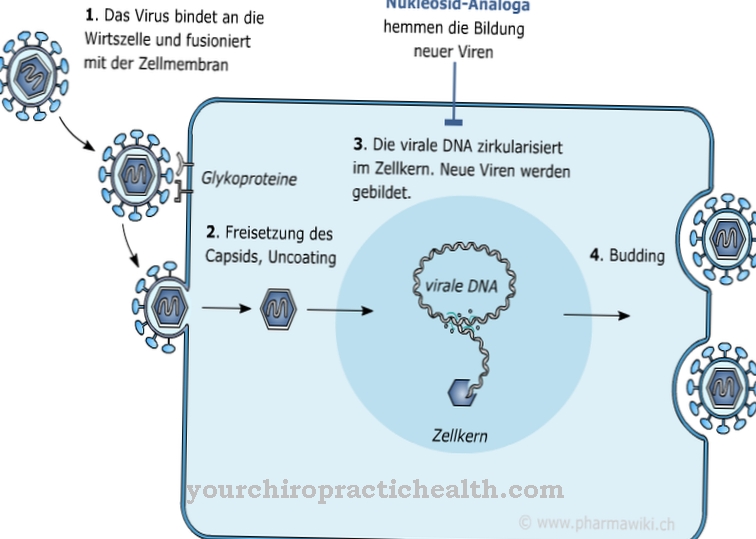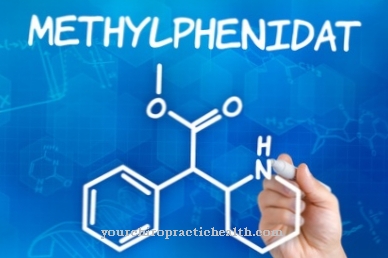The active substance Ampicillin is an antibiotic from the large group of penicillins. Due to its broad spectrum of activity, ampicillin is used successfully against a number of bacterial infections.
What is ampicillin?

Ampicillin is a drug that inhibits bacteria and is one of the semi-synthetic beta-lactam antibiotics. It is effective against both gram-positive and gram-negative bacteria. Numerous gram-negative rod pathogens also respond well to the active ingredient.
Since ampicillin can be used against a wide range of different pathogens, it is one of the so-called broad spectrum antibiotics. Ampicillin is particularly effective against infections with gram-negative rod pathogens, because these have a natural resistance to conventional penicillins.
Chemically, the active ingredient belongs to the amino penicillins. Ampicillin is acid-stable and passes through the gastric tract undamaged without being attacked by the gastric acid. Therefore, this antibiotic is mostly taken in tablet form.
Pharmacological effect
Like body cells, bacteria multiply through continuous cell division. If the cells are in the division phase, new cell walls have to be constantly formed. The drug ampicillin intervenes in this process. The chemical structure of the active ingredient has structures that inhibit the cell wall build-up of bacteria - so-called beta-lactams.
Bacteria contain a certain enzyme that plays a key role in the synthesis - i.e. the construction - of new cell walls. The beta-lactams contained in the drug bind to this enzyme and thus block its receptors. The enzyme is now permanently and irreversibly deactivated. The bacteria are unable to build intact cell walls and can no longer divide.
The active ingredient ampicillin does not kill bacteria, but rather prevents cells from dividing and thus their reproduction. The human immune system is now able to kill the pathogen that is no longer able to divide and to eliminate it via the metabolism. Taken in tablet form, 30-60% of the amino-penicillin is absorbed by the intestinal mucosa and passes into the bloodstream. The unabsorbed part of the active ingredient is excreted in the urine within a short time.
Medical application & use
Ampicillin is used to treat bacterial infections that do not respond to conventional antibiotics. A therapy with ampicillin is promising for a variety of acute and chronic inflammations. These include infections of the respiratory tract, the gastrointestinal tract, the ear, nose and throat area (ENT), the kidneys or the biliary and urinary tract.
But also inflammation of the genital organs and the skin as well as the eyes are among the areas of application. Ampicillin is also used for prophylactic, i.e. preventive, treatment during surgical interventions or dental treatments in order to prevent the development of germs in advance. The active ingredient ampicillin is usually administered in tablet form. In the case of inpatient hospitalization, administration via intravenous or intramuscular syringes and infusions is also possible.
Ampicillin must be taken several times a day, as the drug is quickly eliminated from the body. This is the only way to ensure a constant level of active ingredients. The duration of treatment is an average of 10 days. Usually, an initial improvement in general well-being is noticeable just a few hours after ingestion - the symptoms of the disease also decrease significantly.
But even after the symptoms have completely subsided, the intake must be continued for a few days in order to prevent the disease from recurring and to counteract future resistances.
Risks & side effects
Compared to other broad spectrum antibiotics such as amoxicillin, ampicillin is less well tolerated when taken orally. This has mainly to do with the fact that a high proportion of the medicinal substance remains in the intestine and there has a negative impact on the natural intestinal flora.
The intestinal flora of healthy people consists of useful microbacterial pathogens that regulate and promote digestive processes. If the intestinal flora is damaged by the action of the drug, nausea, vomiting or diarrhea can occur. As with all penicillins, there is also the possibility of an allergy with ampicillin.
Skin reactions such as itching and redness are part of it. Anaphylactic shock can occur very rarely. a. manifested in difficulty breathing and violent cardiovascular reactions. Skin changes, changes in the blood count, inflammation of the kidneys and blood vessels or swelling in the larynx are very rare.
























.jpg)



